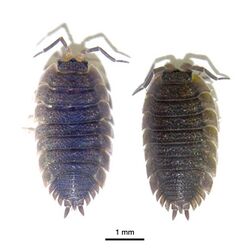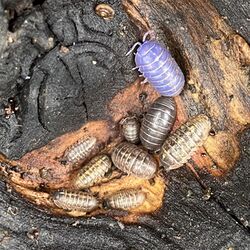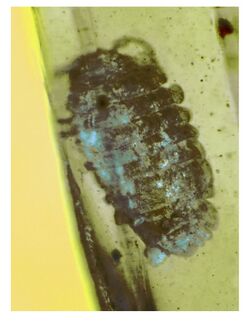Biology:Invertebrate iridescent virus 31
| Invertebrate iridescent virus 31 | |
|---|---|

| |
| Porcellio scaber symptomatic of Invertebrate iridescent virus 31 (L) and individual with typical colouration (R) | |

| |
| Armadillidium vulgare symptomatic of Invertebrate iridescent virus 31 (above) among individuals with typical colouration (below) | |
| Virus classification | |
| (unranked): | Virus |
| Realm: | Varidnaviria |
| Kingdom: | Bamfordvirae |
| Phylum: | Nucleocytoviricota |
| Class: | Megaviricetes |
| Order: | Pimascovirales |
| Family: | Iridoviridae |
| Genus: | Iridovirus |
| Species: | Invertebrate iridescent virus 31
|
| Synonyms | |
| |
| NCBI genome ID | NC_024451 |
|---|---|
| Genome size | 220,222 nucleotides |
| Year of completion | 2014[1] |
Invertebrate iridescent virus 31 (IIV-31), also known informally as isopod iridovirus, is a species of invertebrate iridescent virus in the genus Iridovirus.[2] Oniscidea (commonly known by a variety of names including woodlouse, pillbug, slater, roly-poly, potato bug, et al.) serve as hosts. Infection is associated with decreased responsiveness in the host, increased mortality, and most strikingly, the emergence of an iridescent blue or bluish-purple colour due to the reflection of light off a paracrystalline arrangement of virions within the tissues.[3]
Taxonomy
In earlier centuries, blue individuals of otherwise drab oniscidean species had been discovered. They were sometimes interpreted to be new subspecies and were described as such: Ligidium hypnorum coeruleum Lereboullet 1843 and L. hypnorum amethystinum Schöbl 1861 (in reference to cerulean and amethyst, respectively). In 1980, the first research was published showing that the phenomenon of blue oniscideans is in fact a disease caused by an iridovirus. The aforementioned 'subspecies' have since been reinterpreted, not as distinct taxonomic entities, but as historical findings of individuals infected with this isopod iridovirus.[4]
In 2014, the 220-kilobase genome sequence of this virus was published.[1] Then in 2018 (as part of the 2018b taxonomy release), it was formally accepted as a species by the International Committee on Taxonomy of Viruses, named Invertebrate iridescent virus 31, and placed in the genus Iridovirus alongside the mosquito-hosted species Invertebrate iridescent virus 6.[2]
Host range
IIV-31 infects members of the suborder Oniscidea. In particular, it has been reported in the scientific literature from the following families and species:
- Armadillidiidae (Armadillidium vulgare, A. decorum)
- Cylisticidae (Cylisticus convexus)
- Ligiidae (Ligidium hypnorum, L. koreanum)
- Oniscidae (Oniscus asellus)
- Philosciidae (Burmoniscus kathmandia, Philoscia affinis, P. muscorum)
- Platyarthridae (Niambia capensis)
- Porcellionidae (Porcellio dilatatus, P. laevis, P. siculoccidentalis, P. spinicornis, P. scaber, Porcellionides pruinosus)
- Trachelipodidae (Trachelipus rathkii)
- Trichoniscidae (Androniscus dentiger, Haplophthalmus danicus, H. mengii, Hyloniscus riparius, Trichoniscoides albidus, T. helveticus, Trichoniscus panormidensis, T. pusillus)[5][6]
Geographic range
This virus has a wide geographic distribution. In particular, it has been reported in the scientific literature from:
- Asia (Japan, Turkey)
- Europe (former Czechoslovakia, France, Italy, the Netherlands, Russia, United Kingdom)
- North America (United States)
- Oceania (Australia)[5][6][7][8]
Tentative fossil
An oniscidean fossilised in Early Cretaceous Burmese amber was found that features iridescent blue patches. George Poinar Jr., an entomologist and palaeontologist studying this fossil, tentatively suggested that the colouration may represent an ancient case of IIV-31.[9]
References
- ↑ 1.0 1.1 Piegu B, Guizard S, Tan YP, Cruaud C, Asgari S, Bideshi DK, Federici BA, Bigot Y (2014). "Genome sequence of a crustacean iridovirus, IIV31, isolated from the pill bug, Armadillidium vulgare". Journal of General Virology 95 (7): 1585–1590. doi:10.1099/vir.0.066076-0. PMID 24722681.
- ↑ 2.0 2.1 "ICTV Master Species List 2018b.v2". https://talk.ictvonline.org/files/master-species-lists/m/msl/8266.[|permanent dead link|dead link}}]
- ↑ Wijnhoven H, Berg MP (1999). "Some notes on the distribution and ecology of Iridovirus (Iridovirus, Iridoviridae) in terrestrial isopods (Isopoda, Oniscidae)". Crustaceana 72 (2): 145–156. doi:10.1163/156854099503249.
- ↑ Poinar, George O.; Hess, Roberta T.; Stock, Jan H. (1985-01-01). "Occurrence of the Isopod Iridovirus in European Armadillidium and Porcellio (Crustacea, Isopoda)" (in nl). Bijdragen tot de Dierkunde 55 (2): 280–282. doi:10.1163/26660644-05502007. ISSN 0067-8546. https://brill.com/view/journals/btd/55/2/article-p280_7.xml.
- ↑ 5.0 5.1 Lupetti P, Montesanto G, Ciolfi S, Marri L, Gentile M, Paccagnini E, Lombardo BM (2013). "Iridovirus infection in terrestrial isopods from Sicily (Italy)". Tissue and Cell 45 (5): 321–327. doi:10.1016/j.tice.2013.05.001. PMID 23756498.
- ↑ 6.0 6.1 Karasawa S, Takatsuka J, Kato J (2012). "Report on Iridovirus IIV-31 (Iridoviridae, Iridovirus) infecting terrestrial isopods (Isopoda, Oniscidea) in Japan". Crustaceana 85 (10): 1269–1278. doi:10.1163/15685403-00003116.
- ↑ Lupetti, Pietro; Montesanto, Giuseppe; Ciolfi, Silvia; Marri, Laura; Gentile, Mariangela; Paccagnini, Eugenio; Lombardo, Bianca Maria (2013). "Iridovirus infection in terrestrial isopods from Sicily (Italy)". Tissue & Cell 45 (5): 321–327. doi:10.1016/j.tice.2013.05.001. ISSN 1532-3072. PMID 23756498. https://pubmed.ncbi.nlm.nih.gov/23756498/.
- ↑ Douch JK, Poupa AM (July 2021). "Citizen science data opens multiple avenues for iridovirus research and prompts first detection of Invertebrate iridescent virus 31 in Australia". Journal of Invertebrate Pathology 183: 107619. doi:10.1016/j.jip.2021.107619. PMID 34004165. https://www.sciencedirect.com/science/article/abs/pii/S0022201121000860.
- ↑ Poinar Jr. G (2014). "Evolutionary History of Terrestrial Pathogens and Endoparasites as Revealed in Fossils and Subfossils". Advances in Biology 2014: 1–29. doi:10.1155/2014/181353.
External links
- iNaturalist – citizen science observations of Invertebrate iridescent virus 31
Wikidata ☰ Q85769842 entry
 |


